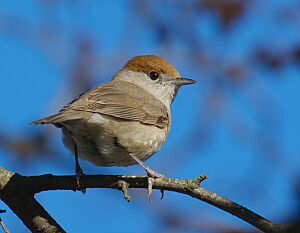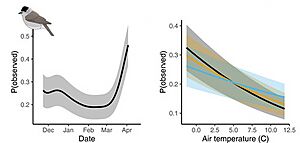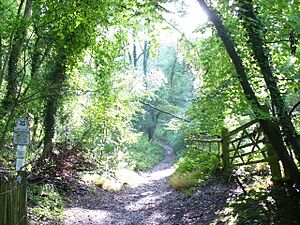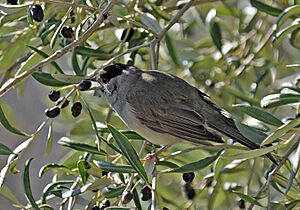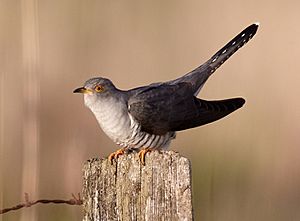Eurasian blackcap facts for kids
Quick facts for kids Eurasian blackcap |
|
|---|---|
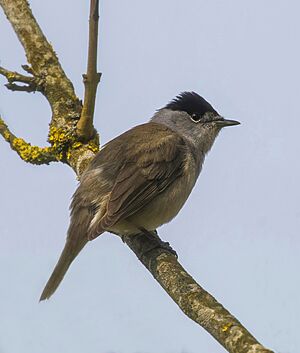 |
|
| Adult male on tree | |
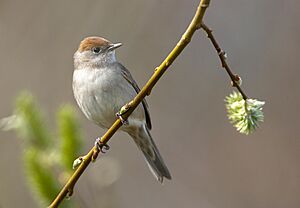 |
|
| Adult female | |
| Conservation status | |
| Scientific classification | |
| Genus: |
Sylvia
|
| Species: |
atricapilla
|
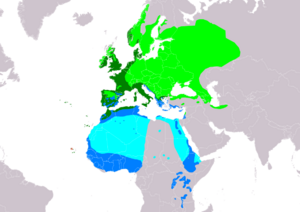 |
|
| Where the blackcap lives: green means they live there all year, light green means they breed there, blue means they spend winter there, light blue means they pass through, and pink means they might be gone. | |
| Synonyms | |
|
|
The Eurasian blackcap (Sylvia atricapilla), often just called the blackcap, is a common and widespread typical warbler. It has olive-grey feathers on its back and pale grey feathers underneath. There are only small differences between the five types, or subspecies, of blackcaps. Both male and female birds have a neat colored cap on their heads. The male's cap is black, while the female's is reddish-brown.
The male blackcap's song is a rich, musical warble. It often ends with a loud, high-pitched part. In some isolated places, like valleys in the Alps, they sing a simpler song. The blackcap's closest relative is the garden warbler. This bird looks quite different but sings a similar tune.
Blackcaps breed in most of Europe, western Asia, and northwestern Africa. They prefer to live in grown-up deciduous woodlands. During breeding season, the male protects his territory. He defends it from other blackcaps and even garden warblers. The nest is a neat cup, built low in brambles or bushes. A typical nest has 4–6 buff-colored eggs. These eggs hatch in about 11 days. The baby birds, called chicks, leave the nest in 11–12 days. Both parents care for them for some time after they fledge.
Blackcaps are migratory birds, meaning they travel. Birds from colder areas spend winter in bushes or trees in northwestern Europe, around the Mediterranean Sea, and in tropical Africa. Some blackcaps from Germany and western Europe have learned to spend winter in gardens in Great Britain and Ireland. During breeding season, blackcaps mainly eat insects. For the rest of the year, they mostly eat small fruits. Garden birds also enjoy bread, fat, and peanuts in winter.
Even though some people hunt them in Mediterranean countries, and they face dangers from predators and diseases, the blackcap has been spreading its range for many years. Because of this, the International Union for Conservation of Nature says it is of least concern. This means it is not in danger of disappearing. Its beautiful song has earned it the nickname "mock nightingale." It has even appeared in books, movies, and music. For example, in Messiaen's opera Saint François d'Assise, the saint is represented by music based on the blackcap's song.
Contents
About the Blackcap
What is a Blackcap?
The blackcap belongs to a group of birds called Sylvia warblers. These are part of a larger family of Old World warblers. The blackcap and its close relative, the garden warbler, are an old pair of species. They separated from other Sylvia birds a very long time ago, about 12 to 16 million years ago. Over time, these two species became so different that they were placed in separate groups.
Carl Linnaeus first described the blackcap in his famous book Systema Naturae in 1758. He called it Motacilla atricapilla. The name Sylvia comes from a Latin word meaning "woodland sprite" or "wood." The species name, atricapilla, means "black-haired." This refers to the male's black cap.
Scientists have found fossils of blackcaps in Europe. The oldest ones are from Bulgaria and are over a million years old. Fossils from France show that the Sylvia group of birds has been around for at least 20 million years.
Different Kinds of Blackcaps
There are five main types, or subspecies, of blackcaps. The differences between them are quite small. For example, some might have slightly greyer feathers or a bit shorter wings.
- S. a. atricapilla: This is the most common type. It lives in Europe (except the Mediterranean area) and northwestern Asia. It spends winter in northwestern Europe down to tropical western Africa.
- S. a. gularis: This type lives in the Azores and Cape Verde islands.
- S. a. heineken: This type lives in Madeira, the Canary Islands, and parts of southwestern Spain and Portugal.
- S. a. pauluccii: This type lives in eastern Spain, Italy, and islands in the western Mediterranean.
- S. a. dammholzi: This type lives in southwestern Asia and spends winter in tropical eastern Africa.
About 2% of male blackcaps on Madeira and the Azores islands are very dark, almost completely black on their heads and upper chests. This dark form is called melanistic. Dark females are rarer.
What Does a Blackcap Look Like?

The blackcap is a mostly grey warbler. Males and females have different colored caps. The most common type is about 13 centimeters (5 inches) long. Its wings are about 7–8 centimeters (2.8–3.1 inches) long. It usually weighs between 16–25 grams (0.6–0.9 ounces). Before migrating, it can weigh up to 31 grams (1.1 ounces).
Adult male blackcaps have olive-grey upper parts. Their neck is a paler grey, and they have a neat black cap on their head. Their underparts are light grey, becoming silvery white on the chin and upper chest. Their tail is dark grey. Their bill and long legs are grey, and their eyes are reddish-brown.
Female blackcaps look like males, but their cap is reddish-brown. Their grey upper parts are also a bit browner. Young blackcaps look similar to females. Young males have a darker brown cap than young females. It's easy to tell blackcaps apart from other similar birds. Other dark-headed warblers have much more black on their heads, not just a small cap. They are also bigger and have white edges on their tails.
Blackcaps change all their feathers, or moult, in August and September before they migrate. Some birds, especially those traveling long distances, moult some feathers again between December and March. Young birds replace their soft baby feathers with adult feathers. This starts earlier but takes longer than for adults.
What Does a Blackcap Sound Like?
The male blackcap's song is a rich, musical warble. It often ends in a loud, high-pitched part. He sings in bursts of up to 30 seconds. He repeats his song for about two-and-a-half minutes, with a short break before each repeat. In some isolated places, like islands or mountain valleys, they sing a simpler, fluting song.
The blackcap's song can be confused with the garden warbler's song. However, the blackcap's song is a bit higher pitched and more broken into separate parts. Both species also have a quiet, muted version of their full song, which is even harder to tell apart. Sometimes, the blackcap copies the songs of other birds, like the garden warbler or the common nightingale.
Their main call sounds like two stones knocking together: tac-tac. Other sounds include a squeaking sweet alarm call and a low trill. Male blackcaps sometimes sing even when they are sitting on eggs. This seems to help them stay connected with the female. Birds spending winter in Africa are quiet at first. But they start singing in January or February before they fly back north.
Where Blackcaps Live
Where Do Blackcaps Live?
Blackcaps breed across Europe, parts of Asia, and northwestern Africa. Birds living on Mediterranean and Atlantic islands, or in milder western and southern areas, often stay in their nesting areas for winter. But blackcaps from other places migrate. Blackcaps from the north travel the furthest south. Blackcaps from the Mediterranean travel shorter distances. Their winter homes overlap with their breeding areas. They also include large parts of West Africa and East Africa.
In Europe, there's a dividing line for migration around 10–11°E longitude. Birds west of this line fly southwest towards Spain or West Africa. Birds east of this line fly to the eastern Mediterranean and then to East Africa. Studies have shown that the urge to migrate and the direction they fly are controlled by their genes.
Climate change seems to be affecting how blackcaps migrate. They are arriving in Europe earlier than before. They are also leaving almost two weeks later than they did in the 1980s. Birds are becoming longer-winged and lighter. This suggests they are flying longer distances as their breeding areas expand north.
In recent years, many blackcaps from mainland Europe have started spending winter in gardens in Great Britain and Ireland. Before, blackcaps only visited these places in summer. The British climate isn't perfect, but there's lots of food, especially from bird tables. The migration distance is also shorter, and they avoid flying over the Alps and the Sahara Desert.
It was once thought that most of these wintering birds came from Germany. Studies showed that these birds mostly mate with each other. They don't usually breed with blackcaps that winter in the Mediterranean or western Africa. This is because the birds that go to Britain arrive back at the breeding grounds earlier. They form pairs before the southern birds arrive.
Now, it seems that blackcaps wintering in the UK come from a wider area. Most come from France, and some even from Spain and Poland. The steady supply of food in gardens helps them gain weight faster than in their usual winter homes.
A study in 2021 showed that blackcaps, especially adults, that winter in Britain and Ireland tend to stay in the same places. They don't move much between wintering spots. Adults that visited gardens were healthier and had smaller fat stores. Their bills were longer and their wing tips rounder. This means they ate a wider variety of foods than birds in traditional winter areas.
Blackcaps didn't only eat in gardens. They visited gardens more when the weather was harsh. They generally stayed at garden sites until just before they left for spring migration. Extra food in winter might help them survive. When getting ready to migrate, lots of food helps blackcaps get into better shape. This might help them breed earlier and more successfully.
Where Do Blackcaps Like to Live?
The blackcap's main breeding home is in mature deciduous woodlands. These woods have good bushes and plants under the trees. They also use other places like parks, big gardens, and overgrown hedges. These places must have tall trees for them to sing from and a good understory of plants.
Where other Sylvia warblers also breed, blackcaps tend to use taller trees. They prefer trees with a good leafy top, like oak trees. In good habitats, there can be 100–200 pairs of blackcaps per square kilometer (250–500 pairs per square mile) in northern Europe. In Italy, it can be 500–900 pairs per square kilometer (1,250–2,250 pairs per square mile). They are much fewer in places like conifer forests. They breed in Europe at heights up to 2,200 meters (7,200 feet).
In winter, around the Mediterranean, they like scrubland and olive groves. The blackcaps that winter in Britain are different. About 95% of them are found in gardens, mostly in towns. In Africa, they live in farmed land, acacia bushes, mangroves, and forests. They are found at heights up to 3,600 meters (11,800 feet) in eastern Africa. Wintering birds move around to find good fruit supplies. But they often stay in good feeding areas and return to them in later winters. Migrating birds can be found in many different places, like reed beds, but they prefer bushy areas.
Blackcap Life and Habits
Protecting Their Home
When male blackcaps return to their breeding areas, they set up a territory. Adult birds that have bred before return to the same spot. New birds wander until they find a good area. They might start with a very large territory that shrinks when neighbors arrive.
They first mark their territory by singing loudly. The male also raises his crown feathers, fans his tail, and flaps his wings slowly. If needed, this display is followed by a chase, which can lead to a fight. In one study in France, a typical territory was about 1.12 hectares (2.8 acres). But in Gibraltar, where there are lots of insects, it was only 0.16 hectares (0.4 acres). Females feed in a larger area that might overlap with other blackcap territories.
Sylvia warblers are special because they strongly defend their territories. They fight against other birds of their own kind and even other Sylvia species. Blackcaps and garden warblers use the same type of woods. But they fight so their territories never overlap.
Reproduction and Life Cycle
Blackcaps start breeding when they are one year old. They usually have one partner, but sometimes both males and females might have other mates. A male attracts a female to his territory by singing and displaying. He raises his black crown feathers, fluffs his tail, flaps his wings slowly, and flies short distances. He also builds one or more simple nests, called "cock nests," usually near where he sings.
The final nest is a neat cup made of roots, stems, and grasses. It is lined with soft materials like hair. The nest is usually about 5.5 centimeters (2.2 inches) deep and 10 centimeters (3.9 inches) across. It is built hidden in brambles, bushes, or trees. The female mainly builds the nest. It can be up to 4.5 meters (15 feet) above the ground, but usually it's lower than 1 meter (3.3 feet).
A typical nest has 4–6 eggs, but can have 2–7. The eggs are usually buff-colored with grey and brown spots. The average egg size is 19.7 x 14.7 millimeters (0.78 x 0.58 inches). Both adults sit on the eggs, or incubate them, for about 11 days (ranging from 10–16 days). Only the female stays on the nest at night.
The chicks are born naked and with closed eyes. Both parents feed them. They leave the nest, or fledge, about 11–12 days after hatching. They leave just before they can fly well. The parents continue to help feed them for another two or three weeks. If the nest is in danger, the parent not on the nest gives an alarm call. This makes the sitting parent and chicks stay still and quiet. A male blackcap might try to scare away a predator. He might also try to lead it away by running and flapping on the ground.
Blackcaps usually raise only one group of chicks per year. But sometimes they have a second group, especially in warmer places. One female was even seen laying 23 eggs in one season!
About 65–93% of eggs hatch successfully. And 75–92% of the chicks grow enough to fledge. The number of young birds that fledge per nest changes depending on the location, how many predators there are, and the quality of their home. In the UK, the average was 2.5 young per nest. About 43% of adult blackcaps survive each year. And 36% of young birds live through their first year. Blackcaps usually live for two years. But the longest recorded life was 13 years and 10 months for a bird in the Czech Republic.
What Do Blackcaps Eat?
Blackcaps mainly eat insects during the breeding season. Then they switch to eating fruit in late summer. This change is caused by their internal biological clock. When migrating birds arrive in their territories, they first eat berries, pollen, and nectar if there aren't enough insects. Then they quickly switch to their favorite insect diet. They mostly pick prey off leaves and twigs. But sometimes they hover, catch insects in the air, or feed on the ground.
Blackcaps eat many different invertebrates. Aphids are very important early in the season. They also eat many flies, beetles, and caterpillars. They swallow small snails whole. The snail shells give them calcium for their eggs. Chicks are mainly fed soft insects. They only get fruit if insects are hard to find.
In July, they start eating more and more fruit. The protein they need for laying eggs and for chicks to grow is replaced by fruit sugar. This sugar helps the birds get fat for migration. They still eat aphids if they are available. This is because aphids often have sugars from the plant sap they eat. Blackcaps eat many kinds of small fruits. They squeeze out any seeds on a branch before eating the fruit pulp. This makes them important for spreading mistletoe seeds.
The blackcaps from mainland Europe that spend winter in British gardens rely on food given by people. Bread and fat are major parts of their diet, each making up about 20%. One bird even survived a whole winter eating only Christmas cake. They also eat fruit, especially cotoneaster, ivy, and honeysuckle. They will eat apples if available. Some birds have learned to take peanuts from feeders. Blackcaps protect good winter food sources in the wild. At garden feeding stations, they chase away bigger birds like starlings and blackbirds. Sometimes, birds become tame enough to eat from a person's hand.
Dangers and Health
Predators and Parasites
Blackcaps can be caught by Eurasian sparrowhawks where they breed. On migration, they can be caught by Eleonora's falcons. Eurasian jays and Eurasian magpies eat their eggs and young. Mammals like stoats, weasels, and squirrels also take eggs and young. Pet cats are the most important predator. They might kill up to 10% of blackcaps.
Blackcaps are sometimes hosts to the common cuckoo. This bird is a brood parasite, meaning it lays its eggs in other birds' nests. But blackcaps often reject the cuckoo's eggs. Blackcaps have developed ways to make it hard for cuckoos to succeed. They are good at spotting eggs that don't belong. Their own eggs within a nest look very similar, making it easier to spot an intruder.
Studies of blackcaps on migration found tiny blood parasites. These parasites were from the genera Haemoproteus and Plasmodium. About 45.5% of males and 22.7% of females had them. But the number of parasites was small. It did not stop the birds from storing fat for their migration flight. Blackcaps can also carry parasitic worms that sometimes harm them. External parasites include chewing lice and feather mites. These mites usually don't cause much damage.
Blackcaps in Culture
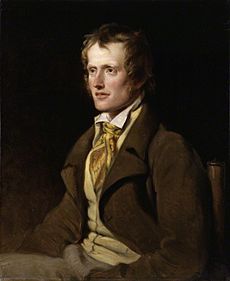
The blackcap's song has led to it being called the "mock nightingale" or "country nightingale." The English poet John Clare wrote about it in "The March Nightingale." He described how a listener might think the rarer nightingale has arrived too early. The song is also the subject of Italian poet Giovanni Pascoli's poem "La Capinera" (The Blackcap).
Giovanni Verga's 1871 novel Storia di una capinera (Story of a Blackcap) was inspired by a blackcap trapped in a cage. The bird, sad for its lost freedom, eventually dies. In the book, a nun falls in love but must return to her convent. The novel was made into films in 1917, 1943, and 1993. The last version was directed by Franco Zeffirelli and called Sparrow in English. In Saint François d'Assise, an opera by Messiaen, the music is based on bird songs. St Francis himself is represented by the blackcap's song.
Old names for the blackcap often refer to its black cap. Some names include "black-headed peggy" and "coal hoodie." Other names refer to its song, like the "nightingale" names. Some old names are based on where it builds its nest, like "Jack Straw" or "hay bird." The Royal Navy's Fleet Air Arm bases are often named after birds. A former base in Cheshire, England, was called HMS Blackcap.
Blackcap Status
The blackcap lives in a very large area. Its population in Europe is estimated to be between 41–65 million breeding pairs. If you include birds breeding in Africa and Asia, the total population is between 101 and 161 million birds. Because of its large numbers, the International Union for Conservation of Nature says it is of least concern. This means it is not considered to be in danger.
Blackcaps and other small birds are sometimes illegally caught and hunted in large numbers in Mediterranean countries. This happens especially in Lebanon, Syria, Palestine, Malta, Libya, Egypt, and Cyprus. There, they are sometimes eaten as a special dish.
Despite hunting and natural dangers, the number of blackcaps in Europe has been growing for many decades. Their range is expanding northwards, for example, into Scotland and Denmark. Sometimes, they are seen nesting outside their main range, like in northern Israel or the Faroes. Wandering birds may appear even further away, like in Iceland or on islands in Arctic Russia. In the Baltic Sea area, the blackcap's spread seems to have been helped by empty territories. These territories were once used by the barred warbler, which is now declining.
Images for kids



